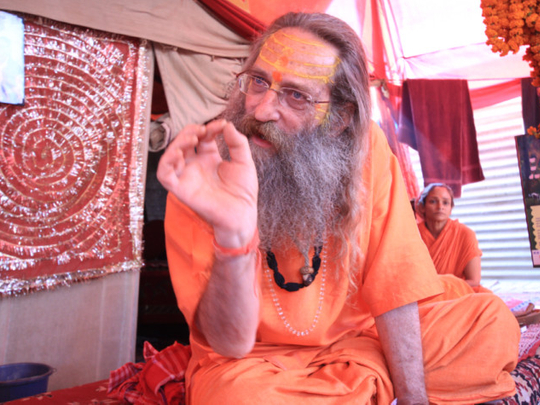
Bang in the middle of Maha Kumbh Nagar, a mammoth tent city in Allahabad built for the Maha Kumbh festival, lies a large boulevard flanked by colourful arches leading to campsites of different Hindu Naga monasteries. Beyond these arches live thousands of sadhus or ascetics who descend from their retreats in the Himalayan foothills to spend weeks here on the banks of the Ganges during the festival. This boulevard is the centrepiece of Maha Kumbh, and occupants of these camps or Akharas (literally meaning wrestling schools) are revered and feared both by pilgrims and officials.
Juna Akhara camp is one of the biggest and occupies a commanding space in the boulevard. Many believe India’s sadhus and yogis were formalised into a monastic order — Order of the Sanyasis or renunciates — by the 5th-century BC Hindu philosopher Adi Shankaracharya. Two centuries later about 52 branches in the Order of Sanyasis were formalised into a society today known as Juna Akhara.
First to greet visitors inside this sprawling complex of bright-coloured carpeted tents is a tall bearded white man with blue eyes, broad forehead, wearing a saffron robe and an aura that captivates his audience. “I left the golden road of Hollywood for this life in India,” says American expatriate Baba Rampuri in an interview to Weekend Review. To the visitors and disciples sitting on the ground around a dhuni (sacred fire), Rampuri is no ordinary Baba. He is the first Westerner to be initiated into the ancient Indian order of Naga Sanyasis. Four decades after he was ordained on the bank of Ganges during the 1971 Kumbh, Rampuri today occupies a senior position in Juna Akhara, a rare feat for a foreigner. Since his initiation, Rampuri, 62, has formed a Hindu ashram or retreat in Haridwar, sits on the Council of Elders of another ashram in Ujjain and has had a permanent seat in Juna Akhara since 2010. That year, a first in its 1,300-year history, he was made the international representative of Juna Akhara, which has members in 90 countries.
On February 9, a day before Maha Kumbh Nagar is to host the world’s biggest gathering of humanity of about 35 million devotees, Rampuri is surrounded by his disciples from Japan, Europe, the United States and India. He blesses them with a pinch of ash from the sacred fire, burning day and night inside his camp. “We offer everything we consume to this agni (fire) as mark of our tyag (sacrifice) to Maha Kumbh,” Rampuri says in his distinct Californian accent.
Rampuri spent his childhood in Beverly Hills, sharing classrooms with many “Hollywood biggies”. “No names, please,” he says, adding, “I left home at 18, travelling to Amsterdam, Turkey, Iran, Afghanistan, Pakistan and India.” Rampuri is now as much an Indian as the sadhu in the next camp. “I knew I was home once I reached India,” he says, dismissing a couple of eunuchs who pester him for blessings and money.
Rampuri is quick on his thoughts on India’s post-independence history, accuses Britain of twisting religious identities of Indians and slams America for bullying the East. “The West wants East to remain docile and we (Americans) have a small culture trying to impose its will on a much larger culture. South Asia, which has gone through colonial rule, is now re-establishing its diverse culture,” he says.
Rampuri is a strong votary of peaceful co-existence of Hindus and Muslims in India but seeks to underplay the perception about rising extreme Hindu right: “If fanatic Hindu belief existed it would have become the dominant thought by now. Hinduism is a very sophisticated culture going back thousands of years and it embraces diversity. Indians are the most open-minded people and that is why they invited other religions.”
To prove his point, Rampuri shows a picture of a mahant (head of an Akhara) in Ujjain, a holy city for Hindus in central India. “Look at him, he is wearing a black gown over a saffron robe and he is the peer of Dutt Akhara,” he says, emphasising the words “peer” and “black”, a title and colour associated with Muslim Sufi saints.
“Please note his title is ‘peer’ and 300 Muslims attended his abhishek (coronation) in 2004 in Ujjain,” he adds, elaborating on his argument that Indian sadhus and Muslim Sufi saints were influenced by each other’s religious practices and doctrines.
While Rampuri is quick to launch into a discourse on global developments and offers strong views on the East versus the West, he is unwilling to let anyone dig into his past. “All I can tell you is that wealth in Hollywood didn’t mean anything to me — money doesn’t bring happiness — and that’s why I left Beverly Hills.” But this silence hasn’t clouded his ability to impress his disciples and senior sadhus of Juna Akhara. Over the past few decades, he has mastered the intellectual and spiritual traditions of the Naga world and also learnt astrology.
As international representative of Juna Akhara, Rampuri travels around the world, runs a website (www.rampuri.com), uploads videos on YouTube and has authored a book Autobiography of a Sadhu, which, he curtly says, “is available on flipkart”.


